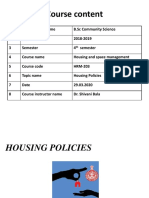Housing - Lecture 2
Housing - Lecture 2
Uploaded by
Anusha FatimaCopyright:
Available Formats
Housing - Lecture 2
Housing - Lecture 2
Uploaded by
Anusha FatimaOriginal Description:
Original Title
Copyright
Available Formats
Share this document
Did you find this document useful?
Is this content inappropriate?
Copyright:
Available Formats
Housing - Lecture 2
Housing - Lecture 2
Uploaded by
Anusha FatimaCopyright:
Available Formats
NPTEL course: Housing Policy and Planning
Dr. Uttam K. Roy, IIT Roorkee: January-March 2017 Week 2
NPTEL course on
Housing Policy and Planning
Week-Two Lectures consist following topics
1) Urban Reforms & Housing
2) Housing Policies
3) Legal Framework for Housing
4) Land for Housing (1,2)
Note:
1. This note have four sections corresponding to five lectures
2. This lecture note is to be referred along with the video lectures for better understanding
1.0 Urban Reforms
In the first week, it was discussed that India faced multiple barriers and difficulty in implementing the
government-sponsored housing schemes. In spite of wishful conceptualization and futuristic project
planning, many projects and government scheme could not see the success as it envisaged. The major
barriers faced by the government in achieving housing for all people has been listed as under:
• Housing affordability
• Speedier technology and system
• Availability of land
• Institutional and policy framework
• Building materials
• Skilled and unskilled labor
• Lack of appropriate standards, norms and schedules
In order to cope up with such constraints, government’s role shifted slowly from a ‘provider’ to ‘enabler’
and then ‘enabler’ to ‘facilitator’. The basic intent is to bring and mobilize all other players of the housing
market in a concerted and converged way. It includes the private housing and infrastructure developers,
manufacturers & assembler, NGOs, PSUs etc. However, in this journey, to facilitate others in a common
objective it was inevitable to bring some changes and amendments in the functioning of the government
too. To bring this change, a set of reforms in terms of legal, process, systems, technology, delivery etc
were mandated at every level through various programmes and schemes. Such reforms are basically the
institutionalized form of new approach and methods of discharging a public service. For housing sector
following major reforms are important to before we proceed further
• 100% FDI in housing projects
• Urban Land ceiling act is repealed
• Reform in land acquisition act
• Real estate investment Fund/trust and Developers Act
• Reform in property tax and stamp duty
• Interest subsidy in housing finance
• Facilitating private developers & JVs
Weekly Lecture Notes 2/8
NPTEL course: Housing Policy and Planning
Dr. Uttam K. Roy, IIT Roorkee: January-March 2017 Week 2
1.1 100% FDI in housing projects
Following the open economic policy of the government of India post 90’s to bring more investors and
business with other countries, 100% funding by any foreign investors was allowed. The basic intent was
to bring more fund inflow in the housing market to enable the existing housing developers in a
competitive way. Many states could get the advantage in bringing such funding for housing and
infrastructure projects. However, the most important criticism it received for such funding was that it
attempted mostly the higher income groups in housing delivery.
1.2 Urban Land ceiling act is repealed
Urban Land Ceiling and Regulation Act (ULCRA) is a state act frame in the 70s in most of the states to
ensure the equitable distribution of urban. Through this act, the bigger land parcels are vested to the
government beyond a certain ceiling (like 500 sqm etc). The government can utilize such vested land for
further development and distribution as the rural land reform in India. However, in spite of achieving
such objective; in few cases, the Act failed to generate larger chunk of land to ensure greater housing and
infrastructure development.
1.3 Reform in land acquisition act
Reform in Land Acquisition and related act also were attempted to address the streamlining the process of
making available urban land for large infrastructure development. The revised Right to Fair
Compensation and Transparency in Land Acquisition, Rehabilitation and Resettlement Act (2013) and
Ordinance (2014) were created to ensure the land acquisition with more transparent and equitable process.
1.4 Real estate investment Fund/trust and Developers Act
The concept of Real Estate Investment fund/Trust was to create a corpus of fund in order to facilitate the
funding of the real estate projects with the accumulated fund from the prospective investors. This is yet to
institutionalized in India.
1.5 Reform in property tax and stamp duty
Reform in property tax and stamp duty was envisaged to achieve a rational and convenient system of
property tax and differential provisions of stamp duty for different income group housing to ensure
affordability for the poor.
1.6 Interest subsidy in housing finance
Interest subsidy for the housing for the poor was very important demand side intervention which came as
a reform during JNNURM and later is was also continued during PMAY.
1.7 Facilitating private developers & JVs
Facilitating private developers and joint venture company with more streamlining approval process of
development schemes and more access to government was also very important reform in housing.
Weekly Lecture Notes 2/8
NPTEL course: Housing Policy and Planning
Dr. Uttam K. Roy, IIT Roorkee: January-March 2017 Week 2
2.0 Housing Policies
A housing policy is set broad and long-term guiding principles which provides a conceptual and futuristic
direction of housing development of the country. A housing policy document is followed by several other
programmes, schemes and actions in the local and regional level. A housing policy must indicate a
direction in the following elements:
• Land supply and land tenure
• Legal and regulatory frame
• Housing Finance
• Participation of partners
• Institutional and operational framework
• Enabling/demand side strategy
• Technology Interface
In India, to satisfy the shelter needs of the underprivileged groups has always been on the national
housing agenda, reflected in the welfare programs mentioned in the Five Year Plans. However, prior to
the 1980s, they were mostly eluded from the programmes designed for them due to unorganized nature of
the housing markets, lack of formal finance and a dedicated policy to regulate the events. Post 1980 the
following policy documents were made by the government of India:
• National Housing Policy 1988, 1994
• National Housing and Habitat Policy 1998
• National Urban housing and habitat Policy 2007
• State Model Affordable Housing Policy 2015
• Draft National Urban Rental Housing Policy 2015
The first concrete step taken by the government to govern the housing sector was the formulation
of National Housing Policy (NHP) and National Housing Bank (NHB) in 1988. Through this initiative,
the government attempted to tackle two of the stated issues – regulatory framework and financing,
respectively. The NHP laid the foundation of housing policy in India and was modified or upgraded in
future as a response to more identified issues. This resulted in the amendment of NHP in 1994 and
formulation of National Habitat and Housing Policy (NHHP) in 1998.
This laid the foundation of the National Urban Housing and Habitat Policy, which was directed
towards tackling the rising housing issues in the urban areas. For the first time, it introduced the concept
of community participation in the housing sector. A major breakthrough was achieved with the
introduction of cross-subsidization, an indirect rather than direct form of subsidy, to encourage the private
developers to enter the market and construct low-cost housing in lieu of added advantages. The NUHHP
postulated the de-centralization of housing delivery and encouraged the states to formulate their
customized housing policies.
It envisaged that the states would prepare a State Urban Housing and Habitat Policy and a State
Urban Housing and Habitat Action Plan. It empowered the States to include passing of specific Acts by
the States to achieve the housing policy objectives through institutional, legal & regulatory reforms, fiscal
concessions, financial sector reforms and innovations in the area of resource mobilization for housing and
related infrastructure development including promotion of cost effective building materials and
technologies at the State level. This was to be overlooked by a state level nodal agency. Additionally,
NUHHP also explored and encouraged the supply of rental housing as an alternative option to ownership,
Weekly Lecture Notes 2/8
NPTEL course: Housing Policy and Planning
Dr. Uttam K. Roy, IIT Roorkee: January-March 2017 Week 2
to reduce the pressure and enhance affordability. Hence, the policy envisioned a multi-pronged multi-
stakeholder approach to provide affordable housing delivery for all.
In order to provide the states a technical guidance for the preparation of State Housing Policies,
emphasizing on the affordable housing segment, a Model State Affordable Housing Policy was prepared
and its draft copy was circulated for stakeholders’ consultation. The aim of MSAHP, prepared in 2015, is
to create an enabling environment for providing “affordable housing for all” with special emphasis on
EWS and LIG and other vulnerable sections of society such as Scheduled castes/Scheduled Tribes,
Backward Classes, Minorities and senior citizens, physically challenged persons in the State and to ensure
that no individual is left shelterless.
The Policy further aims to promote Public Private People Participation (PPPP) for addressing the
shortage of adequate and affordable housing. The target group for the said policy would be urban poor i.e.
persons belonging to the Below Poverty Line, Economically Weaker Sections (EWS) and Lower Income
Groups (LIG) and would be applicable to all cities and towns including that of Census Towns, to enable
planned affordable housing provision. The policy covers various options for housing viz. Ownership,
incremental, rental/social, shelters and other forms. The key interventions and action points are focused
on land, finance, legal and regulatory reforms, technology support and its transfer, provision of
infrastructure, satellite/integrated townships, institutions, capacity building and sustainability concerns.
Providing home ownership to over 18 million households, identified as housing shortage, can prove to be
a challenging task. In an attempt to tackle the issue of growing number of families in urban areas, mostly
with low paying capacities, the National Urban Rental Housing Policy for formulated in 2015.
The above discussion highlights the paradigm shift in the policy approach to increasingly
encourage the stakeholders and market players to collaboratively participate in the process of housing
provision through various mechanisms. The same is envisaged to be carried out in a decentralized manner
to suit the finished product to the local needs, preferences and capacities. Thus the importance of the
localized study of housing markets has been virtually established by the series of housing policies
introduced in India.
3.0 Legal and Institutional Framework for Housing
Housing is primarily a state subject since as per the constitution of India the land and building
construction for housing is mandated in State list and twelfth schedule (list of urban local body). The
Central government can frame the housing policy and programmes at apex level, however the
interventions are to be done at the state level or ULB level organisations. In the three tier government
system, the central government provides legal framework like land acquisition Act, Real Estate Act etc.
Besides it also provides and policy and reform input time to time to facilitate the development process.
Whereas state government operates with the more interventional acts like the town and country planning
act, housing board act, land registration act, slum clearance and related act, municipal act etc. It provides
the necessary organisational capacity to deliver the housing for all categories. The local governments are
mandated to implement all social housing schemes designed by central/state governments. They ensure
development control and building regulations to achieve orderly growth of housing and infrastructure.
ULBs can frame local rules and regulations time to time also if required.
The table below will describe the legal policy and organisational frame for developing housing
and housing infrastructures.
Weekly Lecture Notes 2/8
NPTEL course: Housing Policy and Planning
Dr. Uttam K. Roy, IIT Roorkee: January-March 2017 Week 2
Acts/Legal frame Policy/ Organization Role
Planning
Central Constitution of India NUHHP (MoHUPA) Facilitator
Govt. Land Acquisition act NURHP NHB Streamlining
Developers act BMTPC funding
Other related acts on HUDCO Monitoring
environment, infrastructure HPL
etc
State Town & Country Planning SAHP Dept./Directorate of Enabler
Govt. act PPP Policy Housing/ UD Implementer
Municipal Act Land Policy -Housing Boards Monitoring
Slum Dept./Directorate of T&CP
Clearance/improvement Act -State Planning Board
Developers Organization
Local Local building by-laws/ Housing Dev. Authority Implementer
Govt. regulations strategy/ Master Municipal Corporation Feedback and
plans SPV Evaluation
SFCP NGO
Land Banking Private Developers
4.0 Land for Housing
land is the most important resource associated with the development of housing. It is essential for
a professional who is working in the housing sector to have an idea about land cover and land use and its
relation with housing, land value, land tenure and rights and land supply. The land represents following
features because of which it takes so important roles in housing development.
Most important limited resources
Water, air and other resources are tied with
Provides living spaces with primary products
Frequent wars were fought for land in history
Key factor in production
Right of land determines status
Viewed as input for the scheme of values
Conversion of land is inevitable due to population increase
Outward sprawl in urban centers makes land a scarce commodity in fringes
Naturally making land available in urban or semi-urban areas is a very challenging task. There are
four approaches which can be taken to assemble the developable land.
1. Land acquisition
2. Land use and Development Control
3. Land Assemble using readjustment/pooling/reconstitution
4. Guided land development with Partnership
In India, land use has been identified as a state (provincial) subject matter. Whereas any public
authority can acquire land for ‘public purpose’ as defined in Land Acquisition Act, 1894. Traditionally
Weekly Lecture Notes 2/8
NPTEL course: Housing Policy and Planning
Dr. Uttam K. Roy, IIT Roorkee: January-March 2017 Week 2
compulsory acquisition of land has been a major source of land assembly by the public agency for all
categories of housing and infrastructure development. In 70’s, almost all the state governments came up
with Town and Country Planning Acts in order to control over-use of land for a sustainable development
and significant numbers of such planning authorities were framed accordingly. However, in the 90s,
control over the use of urban land was further percolated to the urban local bodies (ULBs or
municipalities). On the other hand, in order to maintain an equitable distribution, the land ownership
under any individual has been restricted for decades. As a result, until 2000, bigger land parcels were
scarce, especially in urban areas for large housing and other projects. Realizing these, governments
started exploring various models (see Table below) for mobilizing large land for mass housing.
Sl Model Description of Model
no.
1 Joint Venture Cross subsidy based approach started in the state of West Bengal in the year 2000
(JV) Model and later adopted in the scheme named Affordable Housing in Partnership under
JNNURM and PMAY. This model encourages private companies to form JV with
public agencies like municipal authorities, housing boards and development
authorities. Land is acquired by government partner and development right is given
to private partner for developing housing with 50:50 sharing of profit.
2 Land Reform Various legal and policy initiatives taken by government of India towards making
Model land available from the market avoiding any legal and institutional barriers by doing
Repeal of Urban Land Ceiling and Regulation Act (making large land parcels
available)
Amendment of Land Acquisition Act (making the process simple, shorter,
inclusive and effective)
3 Indirect Various tools like Transferable of Development Right (TDR), Variable Floor Area
intervention Ratio, and Reservation for affordable housing and rental housing has been attempted
Model to increase the total supply of homes in piece of land. Rental housing has been
identified in PMAY as a preventive mechanism for the slum formation.
Therefore, the land management in India has been flown into two directions. Firstly the control
over the use of land has been decentralized up to the ULB level and secondly, the extent of ownership of
land has faced multiple restrictions with single ownership, causing scarcity of large land parcels in urban
areas. Through various reforms and interventions as discussed above which government attempted to
deregulate the land and to make it more market friendly to enable developers to develop large housing
projects. In the recently launched PMAY, the government is encouraging similar approach in JV models
through the sub-scheme called Affordable Housing in Partnership (AHP). However, through the state
level housing policies, other approaches like reforms and indirect interventions are applicable for housing.
-------------------------------------------------------
Few questions to think and further study
1. Why is it so important to bring a set of reforms for housing development? Are the current reforms
appropriate or sufficient for the desired housing in India?
2. What is the visible change in housing policies in last decades? What is the implication of real estate act?
3. Is the concept of state model policy appropriate in bringing the contextual intervention? What are the areas
of specialization where state government should look into?
4. Is the local government capable enough to deliver housing for all? What is the futuristic role of state
housing boards in India?
5. Which approach of land assembly is most suitable for housing in India? What are the strength and
weakness of all such approaches?
Weekly Lecture Notes 2/8
You might also like
- Planning Legislation and Legal FrameworkDocument19 pagesPlanning Legislation and Legal FrameworkDivya Purushothaman100% (1)
- Improving Interchanges: Toward Better Multimodal Railway Hubs in the People's Republic of ChinaFrom EverandImproving Interchanges: Toward Better Multimodal Railway Hubs in the People's Republic of ChinaNo ratings yet
- Scientific Glass, Inc. Inventory Management - Case Study 2Document6 pagesScientific Glass, Inc. Inventory Management - Case Study 2CH NAIRNo ratings yet
- Housing Planning and Management - Lecture Notes, Study Material and Important Questions, AnswersDocument5 pagesHousing Planning and Management - Lecture Notes, Study Material and Important Questions, AnswersM.V. TVNo ratings yet
- Urban Design Question BankDocument1 pageUrban Design Question BankVidhisha BhargavaNo ratings yet
- Capital PPT - LVLDocument18 pagesCapital PPT - LVLSushmita Mulekar100% (2)
- Introduction To The Concept of NeighbourhoodDocument38 pagesIntroduction To The Concept of NeighbourhoodKenny CreativesNo ratings yet
- National Urban Housing & Habitat Policy (NUHHP), 2007Document13 pagesNational Urban Housing & Habitat Policy (NUHHP), 2007Mohd Rehan50% (2)
- Housing PoliciesDocument38 pagesHousing PoliciesShreyali Agarwal100% (1)
- Housing PolicyDocument31 pagesHousing PolicyxirochromeNo ratings yet
- Housing Policies in Five Year Plans of IndiaDocument20 pagesHousing Policies in Five Year Plans of IndiaLavanya Jothi Venkatachalam50% (2)
- UDPFI Standards For Urban Area: Planning TechniquesDocument41 pagesUDPFI Standards For Urban Area: Planning TechniquesShashank GargNo ratings yet
- Report On Housing Chapter of 1st To 12th Five Year PlanDocument15 pagesReport On Housing Chapter of 1st To 12th Five Year PlanKartik Barthwal0% (1)
- Urban Housing MCQDocument2 pagesUrban Housing MCQarshad rahman0% (1)
- Gate Questions (Housing) : Heritage Gate Architecture - Planning 2022Document10 pagesGate Questions (Housing) : Heritage Gate Architecture - Planning 2022VinithaNo ratings yet
- Ud QuestionsDocument74 pagesUd QuestionsCherry Ann Hernandez YamatNo ratings yet
- Department of Civil Engineering: Subject-Architecture & Town PlanningDocument48 pagesDepartment of Civil Engineering: Subject-Architecture & Town PlanningNitin kolhe100% (1)
- Classical Revival Building of New DelhiDocument29 pagesClassical Revival Building of New DelhiAashu Sharma100% (1)
- Urban Housing-Question BankDocument6 pagesUrban Housing-Question BankMageshwarNo ratings yet
- The Gujarat Land Pooling Scheme: Paresh L Sharma Chief Town Planner, GUJARAT STATEDocument49 pagesThe Gujarat Land Pooling Scheme: Paresh L Sharma Chief Town Planner, GUJARAT STATEAshraf pathanNo ratings yet
- FinalDocument52 pagesFinalYaSh Shah0% (1)
- UPSC CPWD Architecture 2016Document38 pagesUPSC CPWD Architecture 2016Sweety Kumari100% (1)
- PP - Preuniversity Mcq'sDocument9 pagesPP - Preuniversity Mcq'sPranshu LondaseNo ratings yet
- GATE-Architecture Sample QuestionsDocument6 pagesGATE-Architecture Sample QuestionsCharan ReddyNo ratings yet
- Udpfi - GuidelinesDocument24 pagesUdpfi - Guidelinesnivetha jayaramanNo ratings yet
- Housing National Habitat Policy 2007Document24 pagesHousing National Habitat Policy 2007YuvanshGoelNo ratings yet
- Question Paper Code: X10114: Reg. NoDocument2 pagesQuestion Paper Code: X10114: Reg. NoBhuvanaNo ratings yet
- C A PerryDocument8 pagesC A PerrySam ArulrajNo ratings yet
- Chandigarh-Urban Planning Concepts PDFDocument10 pagesChandigarh-Urban Planning Concepts PDFRajesh SonyNo ratings yet
- Housing in Five Year PlansDocument20 pagesHousing in Five Year PlansLavanya Jothi Venkatachalam100% (2)
- UNIT 1 Urban Housing PDFDocument68 pagesUNIT 1 Urban Housing PDFAnirudh VijayanNo ratings yet
- Slum RedevelopmentDocument16 pagesSlum RedevelopmentchetnaNo ratings yet
- Aranya Housing FinalDocument11 pagesAranya Housing FinalJulia PatelNo ratings yet
- Ar6017 Urban Housing by A Sivaraman 01 - NoDocument156 pagesAr6017 Urban Housing by A Sivaraman 01 - Nosiva ramanNo ratings yet
- Architecture MCQ (Rohit Kumar Verma 170544)Document8 pagesArchitecture MCQ (Rohit Kumar Verma 170544)Sumit SagarNo ratings yet
- GATE Architecture Solved 2011Document12 pagesGATE Architecture Solved 2011Mohd SalahuddinNo ratings yet
- Jaipur Development Plan Existing Profile Jaipur Region Vol 1Document315 pagesJaipur Development Plan Existing Profile Jaipur Region Vol 1Abhishëk ChhonkarNo ratings yet
- National Urban Housing and Habitat Policy, 2007Document30 pagesNational Urban Housing and Habitat Policy, 2007saahasitha 14No ratings yet
- Special Residential Zones (SRZ) Concept NoteDocument8 pagesSpecial Residential Zones (SRZ) Concept NoteavijeetmohantyNo ratings yet
- Ville Contemporaine - SkyscraperDocument2 pagesVille Contemporaine - SkyscraperLaurithaletiixd3No ratings yet
- Naya RaipurDocument21 pagesNaya RaipurNarotham MediNo ratings yet
- Factors Affecting Housing Shortage in IndiaDocument10 pagesFactors Affecting Housing Shortage in IndiaDivisha JindalNo ratings yet
- Urban ConservationDocument16 pagesUrban ConservationMEKHIKA G MOHAN100% (1)
- Unit 2 - Urban HousingDocument22 pagesUnit 2 - Urban HousingMageshwarNo ratings yet
- Urban DesignDocument10 pagesUrban DesignMohamed Yasir ArafathNo ratings yet
- 1 DDocument34 pages1 DVholts Villa VitugNo ratings yet
- Case Study, Indore Slum CityDocument22 pagesCase Study, Indore Slum Cityshikha50% (4)
- Housing SynopsisDocument7 pagesHousing Synopsissuper mageNo ratings yet
- Hierarchy of Planning Authorities in IndiaDocument13 pagesHierarchy of Planning Authorities in Indiasnehasara10100% (2)
- Human Settlement Planning: Unit - 1Document52 pagesHuman Settlement Planning: Unit - 1PRIYA100% (1)
- GATE Architecture & PlanningDocument2 pagesGATE Architecture & PlanningAkanksha VermaNo ratings yet
- Pritzker PrizeDocument4 pagesPritzker PrizeClaire NecesitoNo ratings yet
- Urban Design B.arch NotesDocument1 pageUrban Design B.arch NotesASHWATHINo ratings yet
- Urban PlanningDocument3 pagesUrban PlanningRyan SuarezNo ratings yet
- Development Control Rules and Byelaws in TamilnaduDocument7 pagesDevelopment Control Rules and Byelaws in TamilnaduShaaya ShanmugaNo ratings yet
- 003 PlanningDocument3 pages003 PlanningrcdpreludeNo ratings yet
- Week 2 - 8 LecturesDocument6 pagesWeek 2 - 8 LecturesNishant AgrawalNo ratings yet
- Gist September 2017Document13 pagesGist September 2017Abhijai RajNo ratings yet
- Yojana Summary September 2017 d81d78cb2dDocument16 pagesYojana Summary September 2017 d81d78cb2dnitesh011jhaNo ratings yet
- Housing Policies - IndiaDocument32 pagesHousing Policies - IndiaAjyant SuryaNo ratings yet
- National Urban Rental HousingDocument20 pagesNational Urban Rental HousingPragya ChattreeNo ratings yet
- Mission Report: Assessment of Child Friendly City Initiative (Cfci) Development in The R Epublic of BelarusDocument58 pagesMission Report: Assessment of Child Friendly City Initiative (Cfci) Development in The R Epublic of BelarusAnusha FatimaNo ratings yet
- CFCI Case Study FinlandDocument38 pagesCFCI Case Study FinlandAnusha FatimaNo ratings yet
- National Mission On Sustainable Habitat: Ministry of Housing and Urban Affairs Government of IndiaDocument64 pagesNational Mission On Sustainable Habitat: Ministry of Housing and Urban Affairs Government of IndiaAnusha FatimaNo ratings yet
- Migration TheoriesDocument37 pagesMigration TheoriesAnusha FatimaNo ratings yet
- Detailed Project Report: Improvement of The Water Supply System Package-1 For Gaya Municipal CorporationDocument50 pagesDetailed Project Report: Improvement of The Water Supply System Package-1 For Gaya Municipal CorporationAnusha FatimaNo ratings yet
- Germany and India 2011-2012 - Infinite OpportunitiesDocument3 pagesGermany and India 2011-2012 - Infinite OpportunitiesAnusha FatimaNo ratings yet
- 1034 Part B DCHB GayaDocument504 pages1034 Part B DCHB GayaAnusha FatimaNo ratings yet
- D'F"K Hkwfe Ds CKTKJ Ewy Ds Ekxzn'Kzd FL) Kur O"Kz 2011&12: Izlrkfor Izk:Ik RhuDocument12 pagesD'F"K Hkwfe Ds CKTKJ Ewy Ds Ekxzn'Kzd FL) Kur O"Kz 2011&12: Izlrkfor Izk:Ik RhuAnusha FatimaNo ratings yet
- Housing - Lecture 2Document6 pagesHousing - Lecture 2Anusha Fatima100% (1)
- About Gaya Pind Daan: Auspicious Day For Gaya Sraddha or Pind Dan at GayaDocument1 pageAbout Gaya Pind Daan: Auspicious Day For Gaya Sraddha or Pind Dan at GayaAnusha FatimaNo ratings yet
- Rajesh Nagal PDFDocument38 pagesRajesh Nagal PDFAnusha FatimaNo ratings yet
- Bhopal City ProfileDocument10 pagesBhopal City ProfileAnusha Fatima100% (1)
- Annual Report 2014 15 PDFDocument255 pagesAnnual Report 2014 15 PDFAnusha FatimaNo ratings yet
- 04 Green BuildingDocument16 pages04 Green BuildingAnusha FatimaNo ratings yet
- Manila Electric Company V NLRC, Signo GR 78763Document2 pagesManila Electric Company V NLRC, Signo GR 78763Elvis Jagger Abdul JabharNo ratings yet
- IR - Quiz PaperDocument2 pagesIR - Quiz PaperDeblina SaharoyNo ratings yet
- Chapter 8 - WORLD TRADE ORGANISATIONDocument10 pagesChapter 8 - WORLD TRADE ORGANISATIONAriel A. YusonNo ratings yet
- Certification ProcessDocument8 pagesCertification Processihwan andi patiroyNo ratings yet
- Marketing Mix CourseworkDocument6 pagesMarketing Mix Courseworkbcr7r579100% (2)
- Gedgeon Quijano Vs DBP GR# L-26419, October 16, 1970Document6 pagesGedgeon Quijano Vs DBP GR# L-26419, October 16, 1970Lady Jurist MarsamoloNo ratings yet
- PBMDocument8 pagesPBMKBC KGFNo ratings yet
- Personal Protective Equipment (Ppe)Document16 pagesPersonal Protective Equipment (Ppe)sritaran100% (1)
- ACKNOWLEDGMENT RECEIPT OF PAYMENT Cardinez and CamposDocument1 pageACKNOWLEDGMENT RECEIPT OF PAYMENT Cardinez and CamposJaime GonzalesNo ratings yet
- Brannigan Foods CaseDocument3 pagesBrannigan Foods CaseMaya YammineNo ratings yet
- Marketing Strategy of Borak Real EstateDocument43 pagesMarketing Strategy of Borak Real EstateBorhan UddinNo ratings yet
- Opportunities in Indian Packaging SectorDocument8 pagesOpportunities in Indian Packaging Sectorswapnil118No ratings yet
- BITS Curriculum and TimetableDocument659 pagesBITS Curriculum and TimetableSoumyajit RoyNo ratings yet
- Marsreturnship California Apollo - 12 June 2023Document277 pagesMarsreturnship California Apollo - 12 June 2023Mohammad AslamNo ratings yet
- Schedule of School FeesDocument6 pagesSchedule of School FeesChakri MunagalaNo ratings yet
- Clustering Techniques and DatasetsDocument3 pagesClustering Techniques and DatasetsNile SethNo ratings yet
- An African Success Story: Botswana: Daron Acemoglu Simon Johnson James A. RobinsonDocument4 pagesAn African Success Story: Botswana: Daron Acemoglu Simon Johnson James A. RobinsonAgang Nicole BakwenaNo ratings yet
- Chapter 4. Exports Implementation: Email: Phone: 0914676782Document27 pagesChapter 4. Exports Implementation: Email: Phone: 0914676782vinhNo ratings yet
- NUROs Future Challenge To Delivering RobotsDocument4 pagesNUROs Future Challenge To Delivering RobotsVignesh Raja BNo ratings yet
- Employees Compensation DetailsDocument2 pagesEmployees Compensation DetailsS Prem NathNo ratings yet
- Chapter 4: Income Statement and Related Information: Intermediate Accounting, 11th Ed. Kieso, Weygandt, and WarfieldDocument22 pagesChapter 4: Income Statement and Related Information: Intermediate Accounting, 11th Ed. Kieso, Weygandt, and WarfieldReza MaulanaNo ratings yet
- Entrepreneurship 11 - Q3 - LAS - Week3Document14 pagesEntrepreneurship 11 - Q3 - LAS - Week3RubenNo ratings yet
- Avantika Marketing ProjectDocument35 pagesAvantika Marketing ProjectVeer PunmiaNo ratings yet
- Family Business Management: Lecturer: DR Jozo Niskota, UIBS Session 3: Models of Family BusinessDocument38 pagesFamily Business Management: Lecturer: DR Jozo Niskota, UIBS Session 3: Models of Family Businesssirjaxx motivation and rootsNo ratings yet
- Customer Service Point ("CSP") - Retailer AgreementDocument41 pagesCustomer Service Point ("CSP") - Retailer AgreementAMAN SHARMANo ratings yet
- Coinmint vs. Ashton Soniat Fraud CaseDocument8 pagesCoinmint vs. Ashton Soniat Fraud CaseDon HewlettNo ratings yet
- Back-of-the-Envelope Calculation: AssignmentDocument2 pagesBack-of-the-Envelope Calculation: AssignmentMarcelo SalasNo ratings yet
- Pinot Error TerminalDocument24 pagesPinot Error TerminalAkshay SripadNo ratings yet
- Needs EssayDocument2 pagesNeeds EssaySAlain77No ratings yet







































































































